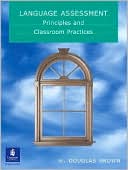Language Assessment - Principles and Classroom Practice
Search in google:
Language Assessment: Principles and Classroom Practices, by best-selling author H. Douglas Brown, offers a clear, comprehensive survey of the essential principles of assessing second language learning, as well as the critical tools teachers need to evaluate performance fairly and effectively. This invaluable resource joins Brown's classic texts, Principles of Language Learning and Teaching and Teaching by Principles, in providing indispensible guidance for second language instruction.Written in Brown's familiar, accessible style, Language Assessment provides a working knowledge of the principles of assessment and their practical application in the classroom. This concise, comprehensive treatment of all four skills includes classification of assessment techniques ranging from controlled to open-ended item types, while a discussion of standardized tests examines their design, purpose, validity, and utility.Additional key features: Clearly framed fundamental principles for evaluating and designing assessment procedures. A focus on classroom-based assessment at all levels of proficiency. A thorough examination of standards-based assessment and standardized testing. A wealth of practical examples to illustrate principles and guidelines. An exploration of the ethics of testing in an educational and commercial world. Comprehensive treatment of alternatives in assessment. A chapter devoted to guidelines and practical suggestions for assigning grades. End-of-chapter exercises and suggested additional readings.
Preface1 Testing, Assessing, and TeachingWhat Is a Test?Assessment and TeachingInformal and Formal AssessmentFormative and Summative AssessmentNorm-Referenced and Criterion-Referenced TestApproaches to Language Testing: A Brief HistoryDiscrete-point and Integrative TestingCommunicative Language TestingPerformance-Based AssessmentCurrent Issues in Classroom TestingNew Views on IntelligenceTraditional and “Alternative” AssessmentComputer-Based TestingExercisesFor Your Further Reading2 Principles of Language AssessmentPracticalityReliabilityStudent-Related ReliabilityRater ReliabilityTest Administration ReliabilityTest ReliabilityValidityContent-Related EvidenceCriterion-Related EvidenceConstruct-Related EvidenceConsequential ValidityFace ValidityAuthenticityWashbackApplying Principles to the Evaluation of Classroom Tests1. Are the test procedures practical?2. Is the test reliable?3. Does the procedure demonstrate content validity?4. Is the procedure face valid and “biased for best”?5. Are the test tasks as authentic as possible?6. Does the test offer beneficial washback to the learner?ExercisesFor Your Further Reading3 Designing Classroom Language TestsTest TypesLanguage Aptitude TestsProficiency TestsPlacement TestDiagnostic TestsAchievement TestsSome Practical Steps to Test ConstructionAssessing Clear, Unambiguous ObjectivesDrawing Up Test SpecificationsDevising Test TasksDesigning Multiple-Choice Test Items1. Design each item to measure a specific objective2. State Both stem and options as simply and directly as possible3. Make certain that the intended answer is clearly the only correct one4. Use item indices to accept, discard, or revise itemsScoring, Grading, and Giving FeedbackScoringGradingGiving FeedbackExercisesFor Your Further Reading4 Standardized TestingWhat Is Standardization?Advantages and Disadvantages of Standardized TestsDeveloping a Standardized Test1. Determine the purpose and objectives of the test2. Design test specifications3. Design, select, and arrange test tasks/items4. Make appropriate evaluations of different kinds of items5. Specify scoring procedures and reporting formats6. Perform ongoing construct validation studiesStandardized Language Proficiency TestingFour Standardized Language Proficiency TestsTest of English as a Foreign Language (TOEFL®)Michigan English Language Assessment Battery (MELAB)International English Language Testing System (IELTS)Test of English for International Communication (TOEIC®)ExercisesFor Your Further ReadingAppendix to Chapter 4:Commercial Proficiency Tests: Sample Items and TasksTest of English as a Foreign Language (TOEFL®)Michigan English Language Assessment Battery (MELAB)International English Language Testing System (IELTS)Test of English for International Communication (TOEIC®)5 Standards-Based AssessmentELD StandardsELD AssessmentCASAS and SCANSTeacher StandardsThe Consequences of Standards-Based and Standardized TestingTest BiasTest-Driven Learning and TeachingEthical Issues: Critical Language TestingExercisesFor Your Further Reading6 Assessing ListeningObserving the Performance of the Four SkillsThe Importance of ListeningBasic Types of ListeningMicro- and Macroskills of ListeningDesigning Assessment Tasks: Intensive ListeningRecognizing Phonological and Morphological ElementsParaphrase RecognitionDesigning Assessment Tasks: Responsive ListeningDesigning Assessment Tasks: Selective ListeningListening ClozeInformation TransferSentence RepetitionDesigning Assessment Tasks: Extensive ListeningDictationCommunicative Stimulus-Response TasksAuthentic Listening TasksExercisesFor Your Further Reading7 Assessing SpeakingBasic Types of SpeakingMicro- and Macroskills of SpeakingDesigning Assessment Tasks: Imitative SpeakingPhonePass TestDesigning Assessment Tasks: Intensive SpeakingDirected Response TasksRead-Aloud TasksSentence/Dialogue Completion Tasks and Oral QuestionnairesPicture-Cued TasksTranslation (of Limited Stretches of Discourse)Designing Assessment Tasks: Responsive SpeakingQuestion and AnswerGiving Instructions and DirectionsParaphrasingTest of Spoken English (TSE)Designing Assessment Tasks: Interactive SpeakingInterviewRole PlayDiscussions and ConversationsGamesOral Proficiency Interview (OPI)Designing Assessment: Extensive SpeakingOral PresentationsPicture-Cued Story-TellingRetelling a Story, News EventTranslation (of Extended Prose)ExercisesFor Your Further Reading8 Assessing ReadingTypes (Genres) of ReadingMicroskills, Macroskills, and Strategies for ReadingTypes of ReadingDesigning Assessment Tasks: Perceptive ReadingReading AloudWritten ResponseMultiple-ChoicePicture-Cued ItemsDesigning Assessment Tasks: Selective ReadingMultiple-Choice (for Form-Focused Criteria)Matching TasksEditing TasksPicture-Cued TasksGap-Filling TasksDesigning Assessment Tasks: Interactive ReadingCloze TasksImpromptu Reading Plus Comprehension QuestionsShort-Answer TasksEditing (Longer Texts)ScanningOrdering TasksInformation Transfer: Reading Charts, Maps, Graphs, DiagramsDesigning Assessment Tasks: Extensive ReadingSkimming TasksSummarizing and RespondingNote-Taking and OutliningExercisesFor Your Further Reading9 Assessing WritingGenres of Written LanguageTypes of Writing performanceMicro- and Macroskills of WritingDesigning Assessment Tasks: Imitative WritingTasks in [Hand] Writing Letters, Words, and PunctuationSpelling Tasks and Detecting Phoneme-Grapheme CorrespondencesDesigning Assessment Tasks: Intensive (Controlled) WritingDictation and Dicto-CompGrammatical Transformation TasksPicture-Cued TasksVocabulary Assessment TasksOrdering TasksShort-Answer and Sentence Completion TasksIssues in Assessing Responsive and Extensive WritingDesigning Assessment Tasks: Responsive and Extensive WritingParaphrasingGuided Question and AnswerParagraph Construction TasksStrategic OptionsTest of Written English (TWE®)Scoring Methods for Responsive and Extensive WritingHolistic ScoringPrimary Trait ScoringAnalytic ScoringBeyond Scoring Responding to Extensive WritingAssessing Initial Stages of the Process of ComposingAssessing Later Stages of the Process of ComposingExercisesFor Your Further Reading10 Beyond Tests: Alternatives in AssessmentThe Dilemma of Maximizing Both Practicality and WashbackPerformance-Based AssessmentPortfoliosJournalsConferences and InterviewsObservationsSelf- and Peer-AssessmentsTypes of Self- and Peer-AssessmentGuidelines for Self- and Peer- AssessmentA Taxonomy of Self- and Peer-Assessment TasksExercisesFor Your Further Reading11 Grading and Student EvaluationPhilosophy of Grading: What Should Grades Reflect?Guidelines for Selecting Grading CriteriaCalculating Grades: Absolute and Relative GradingTeachers’ Perceptions of Appropriate Grade DistributionsInstitutional Expectations and ConstraintsCross-Cultural Factors and the Question of DifficultyWhat Do Letter Grades “Mean”?Alternatives to Letter GradingSome Principles and Guidelines for Grading and EvaluationExercisesFor Your Further ReadingBibliographyName IndexSubject Index








